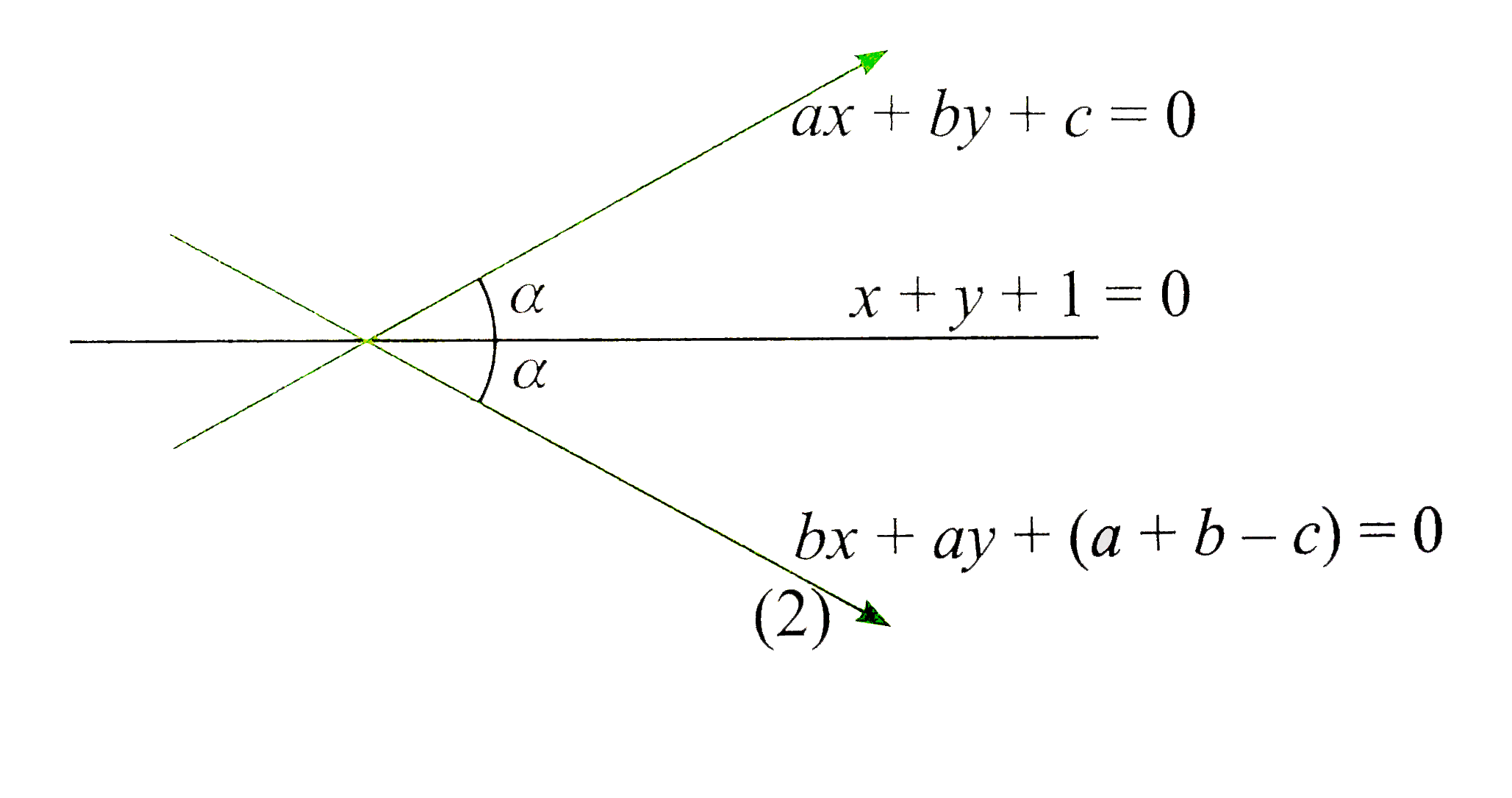Show that the reflection of the line ax+by+c=0 on the line x+y+1=0 is the line bx+ay+(a+b−c)=0 where a≠b.Solution in Bengali

We have lines
ax+by+c=0 (1)
x+y+1=0 (2)
bx+ay+(a+b−c)=0 (3)
Equations of angle bisectors of (1) and (3) are
|ax+by+c|√a2+b2=|bx+ay+a+b−c|√a2+b2
or ax+by+c=±(bx+ay+a+b−c)
or x+y+1 =0 and (a-b)x+(b-a)y =a+b-2c
Since x+y+1= 0 is one of the bisectors of lines (1) and (3), reflection of line (1) in line (2) is line (3).
Topper's Solved these Questions
- STRAIGHT LINESBOOK - CENGAGE PUBLICATIONCHAPTER - STRAIGHT LINESEXERCISE - CONCEPT APPLICATION EXERCISE 2.6
5 Videos
- STRAIGHT LINESBOOK - CENGAGE PUBLICATIONCHAPTER - STRAIGHT LINESEXERCISE - EXERCISE (SINGLE CORRECT ANSWER TYPE)
82 Videos
- STRAIGHT LINESBOOK - CENGAGE PUBLICATIONCHAPTER - STRAIGHT LINESEXERCISE - CONCEPT APPLICATION EXERCISE 2.4
8 Videos
- STRAIGHT LINEBOOK - CENGAGE PUBLICATIONCHAPTER - STRAIGHT LINEEXERCISE - Multiple Correct Answers Type
8 Videos
- THEORY OF EQUATIONSBOOK - CENGAGE PUBLICATIONCHAPTER - THEORY OF EQUATIONSEXERCISE - JEE ADVANCED (Numerical Value Type )
1 Videos
Similar Questions
If aandb are two arbitrary constants, then prove that the straight line (a−2b)x+(a+3b)y+3a+4b=0 will pass through a fixed point. Find that point.
View SolutionFind the equations of the diagonals of the square formed by the lines x=o,y=0,x=1andy=1.
View SolutionThe point (8,−9) with respect to the lines 2x+3y−4=0 and 6x+9y+8=0 lies on
View SolutionThe point P(α,α+1) will lie inside the triangle whose vertices are A(0,3),B(−2,0) and C(6,1) if
View SolutionThe number of distinct real roots of x4−4x3+12x2+x−1=0is_____.
View SolutionShow that the reflection of the line ax+by+c=0 on the line x+y+1=0 is the line b+ay+(a+b−c)=0 where a≠b.
View SolutionIf the lines x+ay+a=0, bx+y+b=0 and cx+cy+1=0 are concurrent, then write the value of 2abc−ab−bc−ca.
View SolutionFind the equation of the plane containing the line yb+zc=1,x=0, and parallel to the line xa−zc1,y=0.
View SolutionIf the line x+y=0 touches the curve y=x2+bx+c at the point x=−2, then : (b,c)≡
View SolutionShow that the straight lines (a−b)x+(b−c)y=c−a,(b−c)x+(c−a)y=a−b and (c−a)x+(a−b)y=b−c are concurrent.
View SolutionShow that the reflection of the line ax+by+c=0 on the line x+y+1=0 is the line b+ay+(a+b−c)=0 where a≠b.
View SolutionFind the equation of the plane containing the line yb+zc=1,x=0, and parallel to the line xa−zc1,y=0.
View SolutionShow that the reflection of the line ax+by+c=0 on the line x+y+1=0 is the line bx+ay+(a+b−c)=0 where a≠b.
View SolutionIf the lines ax+y+1=0,x+by+1=0 and x+y+c=0 are concurrent (a≠b≠c≠1) , prove that 11−a+11−b+11−c=1 .
View SolutionShow that the following lines are concurrent: L1=(a−b)x+(b−c)y+(c−a)=0 L2=(b−c)x+(c−a)y+(a−b)=0 L3=(c−a)x+(a−b)y+(b−c)=0
View SolutionShow that the straight lines L1=(b+c)x+ay+1=0, L2=(c+a)x+by+1=0 nd L3=(a+b)x+cy+1=0 are concurrent.
View Solution
